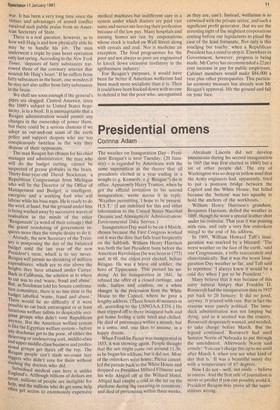Presidential omens
Corinna Adam
The weather on Inauguration Day — President Reagan's is next Tuesday, (20 January) — is regarded by Americans with the same superstition as the theory that all presidents elected in a year ending in a nought (e.g. Kennedy, e.g. Reagan?) die in office. Apparently Harry Truman. when he got the official invitation to his second inauguration, wrote across it in reply, 'Weather permitting, I hope to be present. H.S.T.' (I am indebted for this and other information to the United States National Oceanic and Atmospheric Administration: Environmental Data Service.) Inauguration Day used to be on 4 March, chosen because the First Congress worked out it was the date that falls least frequently on the Sabbath. William Henry Harrison was both the last President born before the American Revolution (he was born in 1773) and, at 68, the oldest ever elected, before Reagan. He was a brave old soldier, the hero of Tippecanoe. This proved his undoing. At his inauguration in 1841, he refused the offer of a closed carriage, and rode, hatless and coatless, on a white charger in the procession from the White House to the Capitol, where he gave a lengthy address. (Three hours 40 minutes in all, according to the USNOAA ;EDS.) He then tripped off to three inaugural balls and got home feeling a little tired and chilled. He died of pneumonia within a month; but in a coma, and, one likes to assume, in a happy dream.
When Franklin Pierce was inaugurated in 1853, it was snowing again. People thought that the sun might come out around 11.30, as he began his address, but it did not. Most of the onlookers went home; Pierce cancelled the parade back to the White House and dropped ex-President Millard Fillmore and his wife Abigail off at the Willard Hotel. Abigail had caught a cold as she sat on the platform during the swearing-in ceremony, and died of pneumonia within three weeks. Abraham Lincoln did not develop pneumonia during his second inauguration in 1865 (he was first elected in 1860) but a lot of other people did. The city of Washington was so deep in yellow mud that the Army engineers had, apparently, tried to put a pontoon bridge between the Capitol and the White House., but failed because the 'bottom' was too squashy to hold the anchors of the workboats.
William Henry Harrison's grandson, Benjamin Harrison, defied the weather in 1889, though he wore a special leather shirt under his overcoat. That year it was pouring with rain, and only a very few onlookers stayed to the end of his address.
In 1909, William Howard Taft's inauguration was marked by a blizzard. 'The worst weather on the face of the earth,' said one Congressman, a trifle inaccurately and chauvinistically. But it was the worst Inauguration Day weather so far, and Taft said to reporters: 'I always knew it would be a cold day when I got to be President.'
Many believe that it was because of this sorry natural history that Franklin D. . Roosevelt had the inauguration date in 1937 put back to 20 January. It did no good, anyway.• It poured with rain. But in fact the reasons were purely political. The lameduck administration was not limping but dying, and so it seemed was the country.. Roosevelt desperately wanted, and needed, to take charge before March. But the legend continued. Roosevelt had used Senator Norris of Nebraska to put through the amendment. Afterwards Norris said crossly: 'You can't charge this up to me until after March 4, when you see what kind of day that is.' It was a beautiful sunny day with a temperature of 67 degrees.
Now I do not — well, not really — believe in omens. And the first rule of journalism is never to predict if you can possibly avoid it. President Reagan may prove all the superstitions wrong.


































 Previous page
Previous page